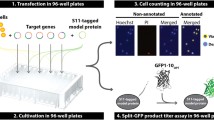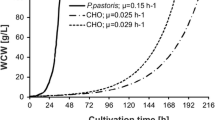Abstract
Biopharmaceuticals represented by immunoglobulin G (IgG) are produced by the cultivation of recombinant animal cells, especially Chinese hamster ovary (CHO) cells. It is thought that the intracellular secretion process of IgG is a bottleneck in the production of biopharmaceuticals. Many studies on the regulation of endogenous secretory protein expression levels have shown improved productivity. However, these strategies have not universally improved the productivity of various proteins. A more rational and efficient establishment of high producer cells is required based on an understanding of the secretory processes in IgG producing CHO cells. In this study, a CHO cell line producing humanized IgG1, which was genetically fused with fluorescent proteins, was established to directly analyze intracellular secretion. The relationship between the amount of intracellular and secreted IgG was analyzed at the single cell level by an automated single-cell analysis and isolation system equipped with dual color fluorescent filters. The amounts of intracellular and secreted IgG showed a weak positive correlation. The amount of secreted IgG analyzed by the system showed a weak negative linear correlation with the specific growth of isolated clones. An immunofluorescent microscopy study showed that the established clones could be used to analyze the intracellular secretion bottleneck. This is the first study to report the use of fluorescent protein fusion IgG as a tool to analyze the secretion of recombinant CHO cells.






Similar content being viewed by others
References
Baek E, Kim CL, Park JH, Lee GM (2015) Cell engineering for therapeutic protein production. In: Al-Rubeai M (ed) Animal cell culture, Cell engineering, vol 9. Springer, Cham, pp 565–590
Bandaranayake AD, Almo SC (2014) Recent advances in mammalian protein production. FEBS Lett 588:253–260. https://doi.org/10.1016/j.febslet.2013.11.035
Barnes LM, Dickson AJ (2006) Mammalian cell factories for efficient and stable protein expression. Curr Opin Biotechnol 17:381–386. https://doi.org/10.1016/j.copbio.2006.06.005
Bhoskar P, Belongia B, Smith R et al (2013) Free light chain content in culture media reflects recombinant monoclonal antibody productivity and quality. Biotechnol Prog 29:1131–1139. https://doi.org/10.1002/btpr.1767
Bibila TA, Flickinger MC (1991) A model of interorganelle monoclonal antibody transport and secretion in mouse hybridoma cells. Biotechnol Bioeng 38:767–780. https://doi.org/10.1002/bit.260380711
Borth N, Mattanovich D, Kunert R, Katinger H (2005) Effect of increased expression of protein disulfide isomerase and heavy chain binding protein on antibody secretion in a recombinant CHO cell line. Biotechnol Prog 21:106–111. https://doi.org/10.1021/bp0498241
Chuang K-H, Hsieh Y-C, Chiang I-S et al (2014) High-throughput sorting of the highest producing cell via a transiently protein-anchored system. PLoS ONE 9:e102569. https://doi.org/10.1371/journal.pone.0102569
Davis R, Schooley K, Rasmussen B et al (2000) Effect of PDI overexpression on recombinant protein secretion in CHO cells. Biotechnol Prog 16:736–743. https://doi.org/10.1021/bp000107q
DeMaria CT, Cairns V, Schwarz C et al (2007) Accelerated clone selection for recombinant CHO cells using a FACS-based high-throughput screen. Biotechnol Prog 23:465–472. https://doi.org/10.1021/bp060298i
Dinnis DM, James DC (2005) Engineering mammalian cell factories for improved recombinant monoclonal antibody production: lessons from nature? Biotechnol Bioeng 91:180–189. https://doi.org/10.1002/bit.20499
Ecker DM, Jones SD, Levine HL (2015) The therapeutic monoclonal antibody market. MAbs 7:9–14. https://doi.org/10.4161/19420862.2015.989042
Frame KK, Hu W-S (1990) Cell volume measurement as an estimation of mammalian cell biomass. Biotechnol Bioeng 36:191–197. https://doi.org/10.1002/bit.260360211
Griesbeck O, Baird GS, Campbell RE et al (2001) Reducing the environmental sensitivity of yellow fluorescent protein. Mechanism and applications. J Biol Chem 276:29188–29194. https://doi.org/10.1074/jbc.M102815200
Haas AK, Von Schwerin C, Matscheko D, Brinkmann U (2010) Fluorescent Citrine-IgG fusion proteins produced in mammalian cells. MAbs 2:648–661. https://doi.org/10.4161/mabs.2.6.13179
Hasegawa H, Wendling J, He F et al (2011) In vivo crystallization of human IgG in the endoplasmic reticulum of engineered Chinese hamster ovary (CHO) cells. J Biol Chem 286:19917–19931. https://doi.org/10.1074/jbc.M110.204362
Hung F, Deng L, Ravnikar P et al (2010) mRNA stability and antibody production in CHO cells: improvement through gene optimization. Biotechnol J. 5:393–401. https://doi.org/10.1002/biot.200900192
Ishii Y, Murakami J, Sasaki K et al (2014) Efficient folding/assembly in Chinese hamster ovary cells is critical for high quality (low aggregate content) of secreted trastuzumab as well as for high production: stepwise multivariate regression analyses. J Biosci Bioeng 118:223–230. https://doi.org/10.1016/j.jbiosc.2014.01.013
Kaneyoshi K, Uchiyama K, Onitsuka M, et al. (2018) Analysis of intracellular IgG secretion in Chinese hamster ovary cells to improve IgG production. J Biosci Bioeng. https://doi.org/10.1016/j.jbiosc.2018.06.018
Kawabe Y, Makitsubo H, Kameyama Y et al (2012) Repeated integration of antibody genes into a pre-selected chromosomal locus of CHO cells using an accumulative site-specific gene integration system. Cytotechnology 64:267–279. https://doi.org/10.1007/s10616-011-9397-y
Khoo SHG, Al-Rubeai M (2009) Detailed understanding of enhanced specific antibody productivity in NS0 myeloma cells. Biotechnol Bioeng 102:188–199. https://doi.org/10.1002/bit.22041
Kida A, Iijima M, Niimi T et al (2013) Cell surface-fluorescence immunosorbent assay for real-time detection of hybridomas with efficient antibody secretion at the single-cell level. Anal Chem 85:1753–1759. https://doi.org/10.1021/ac303067k
Kim TK, Chung JY, Sung YH, Lee GM (2001) Relationship between cell size and specific thrombopoietin productivity in Chinese hamster ovary cells during dihydrofolate reductase-mediated gene amplification. Biotechnol Bioprocess Eng 6:332–336. https://doi.org/10.1007/BF02933001
Kim W-D, Tokunaga M, Ozaki H et al (2010) Glycosylation pattern of humanized IgG-like bispecific antibody produced by recombinant CHO cells. Appl Microbiol Biotechnol 85:535–542. https://doi.org/10.1007/s00253-009-2152-z
Kuwae S, Miyakawa I, Doi T (2018) Development of a chemically defined platform fed-batch culture media for monoclonal antibody-producing CHO cell lines with optimized choline content. Cytotechnology 70:939–948. https://doi.org/10.1007/s10616-017-0185-1
Lai T, Yang Y, Ng SK (2013) Advances in mammalian cell line development technologies for recombinant protein production. Pharmaceuticals 6:579–603. https://doi.org/10.3390/ph6050579
Li F, Vijayasankaran N, Shen A et al (2010) Cell culture processes for monoclonal antibody production. MAbs 2:466–479. https://doi.org/10.4161/mabs.2.5.12720
Liu H-S, Jan M-S, Chou C-K et al (1999) Is green fluorescent protein toxic to the living cells? Biochem Biophys Res Commun 260:712–717. https://doi.org/10.1006/bbrc.1999.0954
Lloyd DR, Holmes P, Jackson LP et al (2000) Relationship between cell size, cell cycle and specific recombinant protein productivity. Cytotechnology 34:59–70. https://doi.org/10.1023/A:1008103730027
Martínez VS, Buchsteiner M, Gray P et al (2015) Dynamic metabolic flux analysis using B-splines to study the effects of temperature shift on CHO cell metabolism. Metab Eng Commun 2:46–57. https://doi.org/10.1016/j.meteno.2015.06.001
Mathias S, Fischer S, Handrick R et al (2018) Visualisation of intracellular production bottlenecks in suspension-adapted CHO cells producing complex biopharmaceuticals using fluorescence microscopy. J Biotechnol 271:47–55. https://doi.org/10.1016/j.jbiotec.2018.02.009
Mattanovich D, Borth N (2006) Applications of cell sorting in biotechnology. Microb Cell Fact 5:12. https://doi.org/10.1186/1475-2859-5-12
Meng YG, Liang J, Wong WL, Chisholm V (2000) Green fluorescent protein as a second selectable marker for selection of high producing clones from transfected CHO cells. Gene 242:201–207. https://doi.org/10.1016/S0378-1119(99)00524-7
Nishimiya D, Mano T, Miyadai K et al (2013) Overexpression of CHOP alone and in combination with chaperones is effective in improving antibody production in mammalian cells. Appl Microbiol Biotechnol 97:2531–2539. https://doi.org/10.1007/s00253-012-4365-9
O’Callaghan PM, McLeod J, Pybus LP et al (2010) Cell line-specific control of recombinant monoclonal antibody production by CHO cells. Biotechnol Bioeng 106:938–951. https://doi.org/10.1002/bit.22769
Ohya T, Hayashi T, Kiyama E et al (2008) Improved production of recombinant human antithrombin III in Chinese hamster ovary cells by ATF4 overexpression. Biotechnol Bioeng 100:317–324. https://doi.org/10.1002/bit.21758
Okumura T, Masuda K, Watanabe K et al (2015) Efficient enrichment of high-producing recombinant Chinese hamster ovary cells for monoclonal antibody by flow cytometry. J Biosci Bioeng 120:340–346. https://doi.org/10.1016/j.jbiosc.2015.01.007
Omasa T (2002) Gene amplification and its application in cell and tissue engineering. J Biosci Bioeng 94:600–605. https://doi.org/10.1016/S1389-1723(02)80201-8
Omasa T, Higashiyama K, Shioya S, Suga K (1992) Effects of lactate concentration on hybridoma culture in lactate-controlled fed-batch operation. Biotechnol Bioeng 39:556–564. https://doi.org/10.1002/bit.260390511
Onitsuka M, Kim W-D, Ozaki H et al (2012) Enhancement of sialylation on humanized IgG-like bispecific antibody by overexpression of α2,6-sialyltransferase derived from Chinese hamster ovary cells. Appl Microbiol Biotechnol 94:69–80. https://doi.org/10.1007/s00253-011-3814-1
Park S, Han J, Kim W et al (2011) Rapid selection of single cells with high antibody production rates by microwell array. J Biotechnol 156:197–202. https://doi.org/10.1016/j.jbiotec.2011.08.031
Peng RW, Fussenegger M (2009) Molecular engineering of exocytic vesicle traffic enhances the productivity of Chinese hamster ovary cells. Biotechnol Bioeng 102:1170–1181. https://doi.org/10.1002/bit.22141
Peng RW, Guetg C, Tigges M, Fussenegger M (2010) The vesicle-trafficking protein munc18b increases the secretory capacity of mammalian cells. Metab Eng 12:18–25. https://doi.org/10.1016/j.ymben.2009.08.007
Peng RW, Abellan E, Fussenegger M (2011) Differential effect of exocytic SNAREs on the production of recombinant proteins in mammalian cells. Biotechnol Bioeng 108:611–620. https://doi.org/10.1002/bit.22986
Priola JJ, Calzadilla N, Baumann M et al (2016) High-throughput screening and selection of mammalian cells for enhanced protein production. Biotechnol J 11:853–865. https://doi.org/10.1002/biot.201500579
Pybus LP, Dean G, West NR et al (2014) Model-directed engineering of “difficult-to-express” monoclonal antibody production by Chinese hamster ovary cells. Biotechnol Bioeng 111:372–385. https://doi.org/10.1002/bit.25116
Seewöster T, Lehmann J (1997) Cell size distribution as a parameter for the predetermination of exponential growth during repeated batch cultivation of CHO cells. Biotechnol Bioeng 55:793–797. https://doi.org/10.1002/(SICI)1097-0290(19970905)55:5%3C793::AID-BIT9%3E3.0.CO;2-6
Sleiman RJ, Gray PP, McCall MN et al (2008) Accelerated cell line development using two-color fluorescence activated cell sorting to select highly expressing antibody-producing clones. Biotechnol Bioeng 99:578–587. https://doi.org/10.1002/bit.21612
Takagi Y, Kikuchi T, Wada R, Omasa T (2017) The enhancement of antibody concentration and achievement of high cell density CHO cell cultivation by adding nucleoside. Cytotechnology 69:511–521. https://doi.org/10.1007/s10616-017-0066-7
Tigges M, Fussenegger M (2006) Xbp1-based engineering of secretory capacity enhances the productivity of Chinese hamster ovary cells. Metab Eng 8:264–272. https://doi.org/10.1016/j.ymben.2006.01.006
Wurm FM (2004) Production of recombinant protein therapeutics in cultivated mammalian cells. Nat Biotechnol 22:1393–1398. https://doi.org/10.1038/nbt1026
Yokota M, Tanji Y (2008) Analysis of cell-cycle-dependent production of tissue plasminogen activator analogue (pamiteplase) by CHO cells. Biochem Eng J 39:297–304. https://doi.org/10.1016/j.bej.2007.09.016
Yoshimoto N, Kuroda S (2014) Single-cell-based breeding: rational strategy for the establishment of cell lines from a single cell with the most favorable properties. J Biosci Bioeng 117:394–400. https://doi.org/10.1016/j.jbiosc.2013.09.016
Yoshimoto N, Kida A, Jie X et al (2013) An automated system for high-throughput single cell-based breeding. Sci Rep 3:1191. https://doi.org/10.1038/srep01191
Zeyda M, Borth N, Kunert R, Katinger H (1999) Optimization of sorting conditions for the selection of stable, high-producing mammalian cell lines. Biotechnol Prog 15:953–957. https://doi.org/10.1021/bp990089g
Zhou Y, Raju R, Alves C, Gilbert A (2018) Debottlenecking protein secretion and reducing protein aggregation in the cellular host. Curr Opin Biotechnol 53:151–157. https://doi.org/10.1016/j.copbio.2018.01.007
Acknowledgements
The authors would like to thank Dr. Onitsuka in Tokushima University for providing plasmids. We also thank Dr. Yu and Mr. Sakata from AS ONE Corporation for technical assistance with experiments using the automated single-cell analysis and isolation system. We thank Edanz Group (www.edanzediting.com/ac) for editing a draft of this manuscript.
Funding
This work was financially supported by the Project Focused on Developing Key Technology of Discovering and Manufacturing Drugs for Next-Generation Treatment and Diagnosis from the Ministry of Economy, Trade and Industry of Japan and from the Japan Agency for Medical Research and Development (AMED) under Grant Number 17ae0101003 and by Grants-in-aid for Scientific Research from the Japan Society for the Promotion of Science (JSPS; JP26630433, JP26249125, JP17H06157, and JP17J00927).
Author information
Authors and Affiliations
Corresponding author
Ethics declarations
Conflict of interest
The authors declare that they have no conflict of interest.
Rights and permissions
About this article
Cite this article
Kaneyoshi, K., Yamano-Adachi, N., Koga, Y. et al. Analysis of the immunoglobulin G (IgG) secretion efficiency in recombinant Chinese hamster ovary (CHO) cells by using Citrine-fusion IgG. Cytotechnology 71, 193–207 (2019). https://doi.org/10.1007/s10616-018-0276-7
Received:
Accepted:
Published:
Issue Date:
DOI: https://doi.org/10.1007/s10616-018-0276-7




